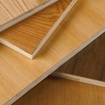Wood Adhesives Market Opportunity Study – 2007
By Leland Orr, Omintech
EXECUTIVE SUMMARY
Against the backdrop of a weak housing market and the current production status of
several key wood composite panel markets, this study attempts to identify the current
soy-based glue opportunities and how these opportunities can be captured. This study
is particularly germane in light of increased soy meal/flour availability as more soy oil is
processed to meet the growing biodiesel demand.
The macroeconomic issues of the U.S. economy are important to understand as they
relate to the current and future status of the wood composite panel markets. The
weaker housing market is a major factor in slowing the U.S. GDP from a 7.5% annual
rate in 2003 to about a 2.5% rate in 2007.
Excessive overbuilding occurred in the 2003-2005 period causing a high inventory of unsold homes with little pent up demand, even with historically low interest rates of five or six percent. Many banks offered exotic and risky loans to lenders who had less than good credit. Some of these loans with balloon payments and/or variable interest rates can not be refinanced today due to tighter credit requirements requiring home owners to sell their houses. This glut of homes has caused existing home sales to decline and home price growth has slowed dramatically. The downturn in the construction market will cause consumption of composite wood panels to decline in the short term and a rebound is not expected until 2009.
On another note, limited forest fiber availability will impact the particle board and
medium density fiberboard markets. Reduction in the North American timber
production, which provides the majority of the sawdust, shavings and chips used by the
particle board (PB) and medium density fiberboard (MDF) manufacturers, has caused a
dip in available fiber. The lumber production is down due to the slump in housing starts
(Table 3). This limited supply of fiber will increase wood costs for PB and MDF, which
has caused production curtailment.
Fiber availability is expected to be tightened in 2007. Improvement will occur in 2008
but remain below 2005-2006 levels. As mentioned before, a healthier rebound in
housing is expected in 2009, which will improve fiber availability and moderate cost
increases in the PB and MDF markets.
There are several promising soy-based adhesive opportunities in spite of this temporary
weakness in the housing market. In 2004, the International Agency for Cancer
Research reclassified formaldehyde from a suspect carcinogen to a known carcinogen.
This began a flurry of technical work on non-formaldehyde containing resins to replace
primarily UF in non-structural wood composite panel glues. In addition, the rising prices
of phenol resins has afforded an opportunity for soy to replace phenol in phenol
formaldehyde glues used in structural wood composite panels.
There are now five soy-based glues to be used in wood composite panels. Oregon
State University began the industry development with soy/kymene resins to be used in
interior hardwood plywood. Other organizations such as Hexion Specialty Chemicals,
Hercules/Heartland, LCB Worldwide and USM Corporation followed with their own
respective soy-based technologies. A more detailed discussion of these resins is
included in the section on soy-based resins. The future of soy-based adhesives rests
upon the cost of soymeal/flour, petrochemical-based product pricing, technology
development and regulatory/legislative actions.
It is difficult to accurately estimate the soybean opportunity in the wood composite area.
After several years of commercial trials, soy meal/flour is only beginning to penetrate
the wood composite glue market. Soy has begun market penetration in the interior
hardwood plywood industry to provide a formaldehyde free glue line. The opportunity
for soy-based glues in the wood composite industry is market dependent.
For the particleboard and medium density fiberboard markets, the greatest interest is having a formaldehyde free resin to resolve the issue of formaldehyde emissions needed to meet current and anticipated regulatory demands and green initiatives such as the
Leadership in Energy and Environmental Design (LEED) Green Building Rating
System™. For the oriented strand board (OSB) and structural plywood markets,
formaldehyde emissions are of much lesser concern than reducing the cost of
petrochemical resins such as phenol formaldehyde and melamines which are
associated with the rising costs of natural gas and oil.
If we assume a 20% market share for soy-based resins in the wood composite resin
business within 4-5 years after market introduction, the total soy meal/flour opportunity
would be approximately 744 million pounds or 18.6 million bushels of soybeans.
Read the entire final_WoodAdhesivesMarketOpportunity


